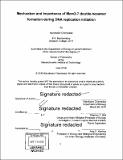Mechanism and importance of Mcm2-7 double-hexamer formation during DNA replication initiation
Author(s)
Champasa, Kanokwan.
Download1121456289-MIT.pdf (12.37Mb)
Other Contributors
Massachusetts Institute of Technology. Department of Biology.
Advisor
Stephen P. Bell.
Terms of use
Metadata
Show full item recordAbstract
All cells must duplicate their genome completely and accurately in each cell cycle. Thus, DNA replication is a highly-regulated multi-step process that ensures the genome is duplicated only once per cell cycle. In eukaryotic cells, initiation of DNA replication begins with loading of two heterohexameric Mcm2-7 helicases around origin DNA during G1 phase. The two helicases are loaded in opposite orientations and interact with each other at their N-terminal domains to form a head-to-head "double hexamer". In S phase, the helicases are activated by helicase-activation proteins to initiate DNA unwinding. Importantly, this event is the committed step of replication initiation. Loading of two helicases in the head-to-head double hexamer ensures DNA unwinding on both sides of the origin and allows the assembly of bi-directional forks essential for complete DNA replication. Two Mcm2-7 helicases are loaded onto the DNA sequentially. The order of events during the first helicase loading has been established, but the mechanism of double-hexamer formation remains unclear. Because the two helicases interact at their N-terminal domains, these regions represent potential mediators of double-hexamer formation. This thesis outlines the potential mechanism and the importance of double-hexamer formation. A conserved motif within Mcm2-7 N-terminal region is required for stable double-hexamer formation and cell viability. Single-molecule analyses of Mcm2-7 containing a mutation within this motif indicated that this mutant form double-hexamer interactions briefly before the two hexamers come apart. Interestingly, after double-hexamer dissolution, the two mutant helicases do not form subsequent double-hexamer interaction. Both wild-type and the mutant Mcm2-7 exhibit double-hexamer interaction rapidly after the arrival of the second Mcm2-7. Together, these data support the model that double-hexamer formation is coordinated with loading of the second Mcm2-7. Finally, the requirement of the double hexamer during helicase activation was investigated using Mcm2-7 complex containing the mutant that inhibits double-hexamer formation. The double hexamer is not essential for recruitment of three critical helicase-activation proteins, but it is required for initial origin DNA unwinding. These findings identify a crucial motif for stable double-hexamer formation and suggest that DNA unwinding is the first step in replication initiation that requires double-hexamer form of the helicases.
Description
Thesis: Ph. D., Massachusetts Institute of Technology, Department of Biology, 2019 Cataloged from PDF version of thesis. Includes bibliographical references.
Date issued
2019Department
Massachusetts Institute of Technology. Department of BiologyPublisher
Massachusetts Institute of Technology
Keywords
Biology.